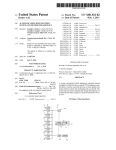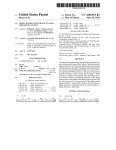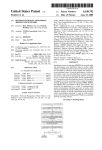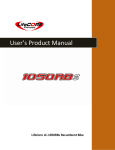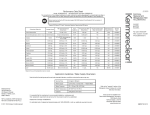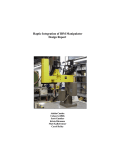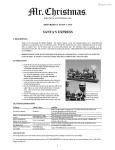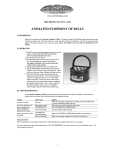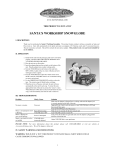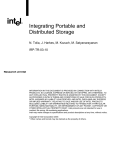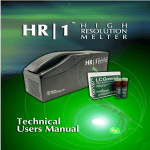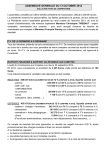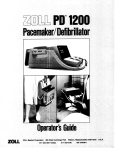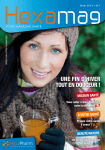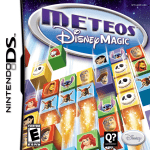Download Device and process for manipulating real and virtual objects in three
Transcript
US007466303B2 (12) Ulllted States Patent (10) Patent N0.: Yi et a]. (54) (45) Date of Patent: DEVICE AND PROCESS FOR MANIPULATING REAL AND VIRTUAL OBJECTS IN THREE-DIMENSIONAL SPACE 6,593,907 B1 (75) Inventors: Dingrong Yi, Toronto (CA); Graham He (73) Ass1gnee: len u’ aO * - ) Bornert et al., In-Plane Position Tracking of Medical Instruments d Sunnybrook Health Sciences Center, Toronto Ontario (CA) _ - - - SubJeCt.tO any dlsclalmerithe term Ofthls patent 1s extended or adjusted under 35 U'S'C' 154(1)) by 1013 days‘ (21) US 2005/0177054 A1 , Coutts et al., Integrated and Interactive Position Tracking and Imag p . 1928. (74) Attorney, Agent, or FirmiSharon J . Adams; Adams LaW Aug. 11, 2005 o?ice US. Cl. ..................... .. 345/156; 345/157; 345/158; (58) Fleld of Classl?catlon Search """" " 345/156’158’ _ _ 3454179; 606/1 See apphcanon ?le for Complete Search hlstory' 57 (2006.01) _ ( ) 606/1 ABSTRACT A device and software system With input and output capabil ity for manipulating real and virtual objects in 3-dimensional space. The device consists of a six degree-of-freedom mechanical armature that has sensors to determine the loca References Cited tion and orientation of a stylus and planar surface. In the input mode, manipulation of the physical armature Will result in a U.S. PATENT DOCUMENTS corresponding two-dimensional, virtual image of the stylus 5,335,557 A 5,576,727 A * 5,729,249 5,792,135 5,805,137 5,923,318 . Assistant ExamineriLeonid Shapiro (52) (56) . (Continued) Int- Cl- _ . 1925. Primary ExamineriRichard Hjerpe (51) _ p ing of Interventional Tools and Internal Devices . . . , Magnetic Resonance in Medicine 198, 4090843 S Prior Publication Data G09G 5/00 Sr Daniel et al., Comparison of Optical and MR-Tracking . . . , SMM Feb. 10, 2004 (65) MRI, SMRMAb t . 1997, Ab tr. 1997, App1.No.: 10/776,421 (22) Filed: ' uilng Cline et a1., Focused US System for MR Imaging, Radlology 194. 731-737, (1995). - Nonce' 7/2003 Demers et al. Ackerman et al., SMRM Abtr. 1986, p. 1131. 0’ ’ ( Dec. 16, 2008 OTHER PUBLICATIONS gm?fgl‘l’?lgfllm Tgrlonijgc‘ék 156g) . US 7,466,303 B2 A A A A 8/1994 Yasutake 11/1996 3/1998 8/1998 9/1998 7/1999 Rosenberg et al. ........ .. 345/179 Yasutake Madhaniet a1. Yasutake Zhaiet a1. 6,101,893 A 8/2000 Wergen 6,115,028 A 6,394,998 B1 6,441,577 B2 9/2000 Balakrishnan et al. 5/2002 Wallace et al. 8/2002 Blumenkranz et al. and surface on a computer screen. The armature also has motors to automatically change the armature location and orientation in order to generate a physical representation in the real World of the location and orientation of a virtual object. The armature is built so that it maintains balance at any location and orientation to statically maintain the armature location and orientation Without drifting to a null rest posi tion. 57 Claims, 9 Drawing Sheets 30 2% MRI Scanner 1 US 7,466,303 B2 Page 2 OTHER PUBLICATIONS Debbins et al., Cardiac Magnetic Resonance Fluoroscopy, Magnetic Resonance in Medicine 361588-595, 1996. Dumoulin et al., Real-Time Position Monitoring of Invasive Devices . . . , Magnetic Resonance in Medicine 1993, 291 411-415. Hardy et al., Interactive Coronary MRI, Magnetic Resonance in Medicine 401105-111, (1998). TPL Roberts et al., Remote Control of Catheter Tip De?ection . . . , Magnetic Resonance in Medicine, vol. 48, No. 6, Dec. 2002, p. 1091, vol. 48, No. 6. Susil et al., Multifunctional Interventional Devices for MRI . . . , Magnetic Resonance in Medicine 471594-600, (2002). Ware, The Visual Computer, pp. 245-253, vol. 6, (1990). ZHAI, Interaction in 3D Graphics, Computer Graphics 32150-54 Kerr et al., Real-Time Interactive MRI on a Conventional Scanner, (1998). Magnetic Resonance in Medicine 381355-367, (1997). ZHAI, Human Performance in Six Degrees of Freedom Input Con Parsons, Inability to Reason About an Object’s Orientation Using an trol, Ph.D. Thesis, University of Toronto, (1995). Axis . . . , Journal of Experimental Psychology: Human Perception and Performance 2111259-1277 (1995). * cited by examiner US. Patent Dec. 16, 2008 Sheet 1 0f9 US 7,466,303 B2 an E2 om / hmc ow 6506 R 3 US. Patent Dec. 16, 2008 Sheet 2 0f9 US 7,466,303 B2 2.Fig. US. Patent Dec. 16, 2008 Sheet 3 0f9 US 7,466,303 B2 US. Patent Dec. 16, 2008 Sheet 4 0f9 om US 7,466,303 B2 US. Patent Dec. 16, 2008 -E.M m\.mn1 M4/m Sheet 5 0f9 M m Em m Q m M \.4/um . . US 7,466,303 B2 a\ M m w m @@ W m 4/ or .96 m US. Patent Dec. 16, 2008 Sheet 6 0f9 US 7,466,303 B2 US. Patent Dec. 16, 2008 Sheet 7 0f9 US 7,466,303 B2 7 Fig. US. Patent Dec. 16, 2008 Sheet 8 0f9 US 7,466,303 B2 8 Fig. US. Patent Dec. 16, 2008 Sheet 9 0f 9 US 7,466,303 B2 .QE @ .sacs? , v3 , sf US 7,466,303 B2 1 2 DEVICE AND PROCESS FOR MANIPULATING REAL AND VIRTUAL OBJECTS IN THREE-DIMENSIONAL SPACE A tWo-dimensional projection of a Wire-frame representation of the scan plane is often not enough to indicate its location and orientation. Considerable mental processing is required for the operator to adequately visualiZe the results of a sequence of translations and/or rotations of the scan plane. Operators often acknowledge the loss of aWareness of the CROSS REFERENCE TO RELATED APPLICATIONS reference frame during real-time MRI. For example, it is Well knoWn in the art that an operator may incorrectly report a Not Applicable. visual impression that the scan plane should go deeper in order to better capture a structure, When in fact the scan plane FEDERAL SPONSORSHIP should actually be shalloWer. Moreover, the operator can only be certain that the last executed prescription is correct When the most recent magnetic resonance (“MR”) image is dis Not Applicable. BACKGROUND played. This “try-and-see”, trial-and-error approach is time 1. Field of the Invention The present invention relates to a six-degree-of-freedom mechanical armature and an integrated software system With consuming and often causes frustration for human operators. In order to overcome the limitations noted above, interest has developed in the design of more intuitive user interfaces. HoWever, most of this Work focuses on softWare development to provide graphical tools (see, for example, Debbins et al., input and output capability for manipulating real and virtual objects in three-dimensional space, and for manipulating a scan plane in magnetic resonance imaging. 2. Description of Related Art 20 al., Magnetic Resonance in Medicine 381355-367, l997). State-of-the-art scan plane prescription is relatively time con suming. Using a standard mouse for pointing and clicking, a Advances in medical imaging technology, including com puteriZed tomography (CT), magnetic resonance imaging (MRI), and positron emission tomography (PET), coupled With developments in computer-based image processing and modeling capabilities, have lead to signi?cant improvements in the ability to visualiZe anatomical structures in human patients. Real-time MRI inherently has advantages over con ventional MRI because of its capability for rapid visualiZa tion of any scan plane and interactive adjustment of location. Interactive MRI is particularly useful for selecting an oblique scan plane in coronary artery cardiac imaging (see, for example, Hardy et al., Magnetic Resonance in Medicine 401105-111, 1998), Real-time MRI also provides visualiZa tion of the dynamic process of anatomical motion, such as arrhythmic cardiac motion and peristalsis in the abdomen, Without requiring any type of respiratory or cardiac monitor ing. Real-time MRI has also been used to guide and monitor interventional procedures (see, for example, Cline et al., Radiology 1941 731-737, 1995; Susie et al., Magnetic Reso nance in Medicine 471594-600, 2002). Development of a 6-DOF system for the manipulation and representation of a scan plane is closely linked With recent Magnetic Resonance in Medicine 361588-595, 1996; Kerr et typical prescription of a double-oblique imaging plane using 25 a commercial ID-rive interface (General Electric Medical Systems, MilWaukee) requires about 20 seconds. During clinical procedures, the precise placement of several scan planes is made even more dif?cult because of other ongoing 30 35 time-limited demands experienced by the operator. For example, during stress echocardiography the operator must potentially record a number of dynamic imaging events, including changes in myocardial Wall motion and tissue blood ?oW, during a period of transient tissue ischemia. To improve the ef?ciency of scan plane prescription, hard Ware devices have been adopted for MRI applications (see, for example, Hardy et al. Magnetic Resonance in Medicine 401105-111 (1998). Although some currently used hardWare devices such as the Spaceball are capable of providing 6-DOF input, their usage is non-intuitive, primarily because the 40 direction and distance of 3-D translation is controlled by the force vector that the operator exerts upon the sphere. Simi larly, the rotation is controlled by the torque. Furthermore, current hardWare devices provide inadequate visual feedback about the spatial location and orientation of the current scan 45 developments in real-time MRI. During real-time MRI, the operator frequently needs to prescribe the scan plane by a plane. Consequently, the operator does not have adequate spatial aWareness and often is left With an unacceptable level of uncertainty concerning the next moving direction. Space sequential translation and/ or rotation of the current scan ball is an isometric device Which is good for rate control, but plane. Typically, a Cartesian coordinate is attached to the not good for position control (see, for example, Zhai Com image plane With the origin of the coordinate system at the center of the image, x pointing to the right, y upWard, and Z out of the image plane toWards the user. The location and orientation of the scan plane are relatively independent. The center of the ?eld-of-vieW can be changed by sliding in the x, y, and Z directions of the image plane While maintaining orientation of the scan plane. Alternatively, the scan plane can be rotated along any x, y, or Z axis Without necessarily chang ing its location. The operation of scan plane prescription is therefore essentially a 6-DOF task, Which generally is di?i cult to perform because of the high dimensionality of the required operations. Human observers normally cannot men tally decompose orientation into separate rotation axes (see, 50 some potential for providing 6-DOF input, hoWever, it suffers the same problem as a Spaceball, namely it returns back to a null rest station When user support is WithdraWn. The prior art does not disclose a method or device that is 55 capable of providing input 6-DOF spatial information While also physically representing the spatial location and orienta tion of the object after the manipulation, Which is also capable of automatically changing its position and gesture to imitate its virtual correspondence. The integration of these capabili 60 ties is essential for the manipulation of a virtual object in 3D space. The present invention discloses a system Wherein an input device provides 6-DOF spatial information Which is for example, Parsons, Journal of Experimental Psychology: integrated With an output device for e?icient and intuitive Human Perception and Performance 2l1l259-l277 (1995). Typically, a ?at-screen is the only resource available to graphically indicate the location and orientation of the scan plane, compounding the problem of scan plane prescription. puter Graphics 32150-54 (1998). Spacemouse might have scan plane prescription. 65 Comparison With Existing Devices The best knoWn and simplest implementation of 6-DOF manipulation is provided by the graphical sliders available on US 7,466,303 B2 3 4 commercial computer screens. In the conventional method of reality World. Similarly, the MITS GloveTM designed by Zhai (Zhai, Human Performance in Six Degrees of Freedom Input MRI scan plane prescription, each slider is dragged With the Control, Ph.D. Thesis, University of Toronto, 1995) provides standard computer mouse With 2-DOF With three sliders devoted to offset the next scan plane along x, y and Z axes 6-DOF input control. HoWever, mo st of these modi?ed high-dimensional “?ying relative to the current plane, and another three for the rotation angles along x, y, and Z axes. HoWever, these conventional methods have fundamental problems. First, an operator can mice” are instrumented With a magnetic tracker for 6-DOF sensing, Which makes them inaccurate in the environment of manipulate only one degree at a time, Which makes it impos MRI. Another draWback is that the devices cannot remain at a particular location Without support, Which makes its dif? cult to resume an incomplete operation due to either fatigue or sible to execute a coordinated movement in 6-DOF space. Second, human operators generally cannot mentally decom re-positioning of the hand. US. Pat. Nos. 5,335,557, 5,729,249, and 5,805,137 issued pose orientation into separate rotation axes (see, for example, Zhai, Computer Graphics 32:50-54, 1998). Consequently, to Yasutake disclose touch sensitive input control isometric devices that are noW available commercially (“Spaceball”m, given a target orientation, an operator cannot determine the rotation angles along each rotation axis required to reach the goal Without ?rst executing several “practice” attempts Spaceball Technologies.) These patented devices provide a family of controllers Which incorporate multiple force/touch blindly. Third, since each scan plane is prescribed relative to the previous scan plane, the axes for rotation are not static and evolve With time. This time-dependence feature makes scan sensitive input elements to provide intuitive input in up to plane prescription even more dif?cult than the operations involved in a ?xed coordinate system. The present invention overcomes all of these problems by enabling the operator to drical, or spherical coordinate systems. Six dimensions of input can be generated Without requiring movement of the controller, Which provides a controller suitable for control ling cursors and display objects in an interactive computer 6-DOF, including position and rotation, in Cartesian, cylin 20 move in a coordinated manner all 6-DOF required for the system. Positional information is obtained either by use of a prescription of a scan plane. Several prior art methods prescribe a double oblique scan plane using a mouse as an input device based on a multi-step 25 “pushing” or “dragging” metaphor. Rotational information is provided by either a “pushing,” “tWisting,” or “gesture” meta procedure. Typically, in the ?rst step of the procedure, tWo phor. The same sensor is used for both positional and rota points placed on a current image plane are connected as a line tional inputs, and the tWo are differentiated by the magnitude Which determines an orthogonal plane to the current plane, of the force applied to the sensor. SpaceballTM devices have been used to prescribe the scan and serves as the intermediate scan plane. After an image is plane of MRI (see, for example, Hardy et al., Magnetic Reso obtained in the intermediate scan plane, the ?rst step in the procedure is repeated to obtain the ?nal scan plane, Which may or may not be the correct ?nal scan plane. In this prior art method for scan plane prescription, additional corrective steps may be required to achieve the correct ?nal scan plane. 30 Moreover, this method does not alloW the user to manipulate 35 the multi-axis hand controller disclosed by US. Pat. No. 6,101,893 to Wergen, noW marketed as “Spacemouse”TM by Logitech U.S.A. “Spacemouse”TM is an elastic device With a small range of movement (5 mm in translation and 4 degree in rotation). A multidimensional handle controlled Without dis is not su?icient in the depth-dimension and often induces visual ambiguity. The present invention overcomes the ?rst problem and solves the second one by providing a physical representation of the scan plane relative to the patient coor dinate. 40 placement is used for precisely positioned control and input. The actuating rod is selectively and simultaneously subjected A mouse is usually classi?ed as a free-moving isotonic 45 nance in Medicine 40:105-111, 1998). The scan plane is rotated on any axis by twisting the sphere around that axis and is translated in any direction by pushing the sphere in that direction. An alternative user interface strategy is provided by in a coordinated manner all degrees-of-freedom at the same time. In addition, this method relies on the ?at screen to display the location and orientation of the scan plane in 3-di mensional space. It is Well known in the art that a ?at screen to lateral pressure and to bending by a surrounding ?st. The third dimension is controlled Without displacement by the thumb, Which acts on an additional sensor lever. There are, hoWever, signi?cant limitations to the inventions embodied by “Spaceball”TM and “Spacemouse”TM, including device Wherein displacement of the device is typically mapped to a cursor displacement. An isometric device, by insuf?cient feedback to the user at the kinesthetic channel comparison, does not move but rather remains ?xed relative (see, for example, Zhai, Computer Graphics 32:50-54, 1998). to a desktop. In general, an isotonic device provides superior performance for positioning tasks compared to an isometric For example, SpaceballTM is completely rigid, Which presents 50 device (see, for example, Zhai, Computer Graphics 32:50-54, feedback can be critical to the operator’s control perfor mance. A second limitation of SpaceballTM is that it returns to a null-position When released giving no feedback on the cur 1 998). Modi?cations to a standard mouse are knoWn in the prior art Which make it possible to input the third coordinate as Well as incorporate 3-D rotations (see, for example, the “Bat” device disclosed by Ware, The Visual Computer, Vol. 6, pp 245-253, 1990). US. Pat. No. 5,503,040 to Wright discloses 55 a computer interface device noW commercially available as “Cricket”TM (Digital Image Design Inc NeW York http://WW W.didi.com/WWW/areas/products/cricket/ Which includes a 60 gimbal mounted handle having a plurality of input members for effectively communicating navigation and command sig nals to a computer. This invention provides an operator With 6-DOF for navigation Within a virtual reality World While simultaneously enabling the operator to enter a series of com mands in order to effectively communicate the operator’s intentions to a computer to effect a change Within a virtual a serious limitation because kinesthetic or proprioceptive 65 rent location in 3-D space of the object under manipulation. The 6-DOF system disclosed by the present invention over comes these problems by being more intuitive in manipulat ing the scan plane. In the method of the present invention, the armature device is capable of maintaining the current location and orientation of the scan plane to provide better spatial aWareness for the operator. In addition, the armature device can be used according to the invention to automatically place the surface to re?ect the prescribed virtual scan plane. 6-DOF Devices in the PriorArt Exemplary of other multi-degree devices is the ?nger manipulable 6-DOF “Fingerball”TM input device disclosed in US. Pat. No. 5,923,318 to Zhai et al. “Fingerball”TM is a 6-DOF isotonic device that an operator holds and freely US 7,466,303 B2 5 6 moves in real 3 -D space to control the position and orientation of a virtual 3-D object. Zhai’s invention provides an isotonic sensitive sWitch Which is activated by the operator squeezing the housing With his ?ngers and/or thumb from any position tion program Which responds to the information provided via the microprocessor and Which can provide force-feedback commands back to the microprocessor. The force feedback is felt by an operator via the user manipulable object. Although the invention disclosed by Rosenberg et al. provides 5- or 6-DOF force feedback control With the feature of static bal ance, it is distinguished from the present invention by the fact that it is incapable of automatically moving to a given position With a desirable orientation. In addition, not all of its joints on the outer surface of the housing. In a preferred embodi can maintain balance. 6-DOF input device Which includes a housing having a shape and dimension effective to permit an operator to grasp and manipulate the housing using the ?ngers of one hand. In one embodiment the housing encloses an interior cavity adapted to contain a position sensor. The entire housing is a pressure ment the input control device is spherical in shape and has a textured outer surface adapted to prevent slippage in the operator’s ?ngers. In addition to the large muscle groups of the shoulders, arm and hand, the input device makes extensive use of the small muscle groups of the ?ngers and thumb. U.S. Pat. No. 6,593,907 issued to Demers et al. discloses a tendon-driven serial distal mechanism for providing 3-DOF for a rotating handle. According to this invention, three stages provide a serial mechanical linkage betWeen a handle and a platform, Which may itself be moveable in three degrees of HoWever, unlike the present invention, the “Fingerball”TM freedom. Each stage has an axis of rotation, and the three axes intersect. The ?rst stage is mounted to the platform in such a Way as to provide rotation about the ?rst stage axis. The ?rst device disclosed by Zhai et al. is not able to maintain its position When support is not provided. U.S. Pat. No. 6,115,028 issued to Balakrishnan et al. dis closes a device for the input of 3 spatial coordinates. Bal akrishnan’s invention provides a three dimensional input sys tem using tilt, an input system for controlling the position or 20 motion of a cursor, and three dimensions that use x, y, and Z positions for inputting tWo coordinates and tilt in a plane (x-y or Z-y) to input a third (and possibly a fourth coordinate). The input system disclosed in Balakrishnan et al. for controlling 25 30 The base of the hand held device is curved so that the device can be tilted even While it is moved in tWo dimensions along the surface of the tablet. Tilting can be along tWo orthogonal axes alloWing the device to input four coordinates if desired. The coil can also have sWitched resistors controlled by mouse buttons connected to it Which the tablet can sense being 35 closed by Demers et al. is not able to automatically position a real object in the real World. those of a conventional mouse. Although the “MicroScribe 3D digitiZer”TM can simultaneously provide 6-DOF inputs, 40 45 armature devices With 6-DOF include several force-feedback hand controllers that are capable of inputting spatial coordi nate/ orientation information and output force feedback. These devices are available commercially as “Freedom 68 Force Feedback Hand Controller”TM (MPB, Montreal, 50 Canada) and “Phantom 6-DOF”TM (SenSable Technologies, USA). U.S. Pat. No. 5,576,727 issued to Rosenberg et al. discloses an electromechanical human-computer interface With force feedback method and apparatus, Which can provide com mands to a computer through tracked manual gestures and tWo orthogonal axes With tWo degrees-of-freedom relative to the support member, extend and retract the support member along the support axis relative to the support bracket and rotate the support member about the support axis relative to the support bracket and thereby move the ?rst Work member of the surgical end effector relative to the support bracket With 60 four degrees-of-freedom. U.S. Pat. No. 6,394,998 issued to Wallace et al. discloses surgical instruments for use in minimally invasive telesurgi cal applications. The instruments include a base Whereby the orientation of the object. A multi-processor system architec ture provides a host computer system interfaced With a dedi cated microprocessor that is responsive to the output of the sensors and provides the host computer With information derived from the sensors. The host computer has an applica operates to reduce friction and enhance force re?ection, and a Wrist mechanism operates to enhance surgical dexterity com pared to standard laparoscopic instruments. The system is optimiZed to reduce the number of actuators required and thus produce a fully functional articulated surgical instrument of minimum siZe. The four actuators are coupled by the four cables to the Wrist mechanism, the rotary joint and the linear joint such that selective actuation of the actuators operates to move the ?rst Work member of the surgical end effector about 55 also provide feedback to the operator through forces applied to the interface. The invention disclosed by Rosenberg et al. provides an operator manipulable object coupled to a mechanical linkage that is, in turn, supportable on a ?xed surface. The mechanical linkage or the operator manipulable object is tracked by sensors for sensing the location and/or U.S. Pat. No. 5,792,135 issued to Madhani et al. discloses an articulated surgical instrument for enhancing the perfor mance of minimally invasive surgical procedures. The instru ment has a high degree of dexterity, loW friction, loW inertia and good force re?ection. A cable and pulley drive system “MicroScribe 3D digitizer”TM cannot be used as an output device to generate a physical representation of the position/ orientation of a virtual object. Other examples of mechanical connected to an idler that carries the third stage tendon. The auxiliary third stage sensor measures angles of rotation that are not measured by the main third stage sensor. The tWo third stage sensors together provide continuous roll measurement about the third stage axis. HoWever, unlike the present inven tion, the device invented by Demers et al. does not represent the position/orientation of the corresponding virtual object. Furthermore, unlike the present invention, the method dis activated to alloW clutching and selection operations like unlike the present invention it cannot statically maintain its position or orientation. Furthermore, unlike the mechanical armature device disclosed by the present invention, the length of the handle. Each stage has a sensor to measure its rotation, and a tendon means of transferring torque from a remote motor to torque about the rotation axis of the respec tive stage. The sensors have tWo limited angle ranges of measurement, about 110 degrees Wide and on opposite sides of the rotation. The third stage has an auxiliary sensor, mounted in quadrature to the main third stage sensor and the position or motion of a cursor. The controlled cursor is moved about on a surface for inputting tWo of the dimensions and tilted to input the third. The amount or degree of tilt and the direction of tilt controls the input of the third dimension. stage carries the second, alloWing the second stage to rotate about its axis. The second stage carries the third stage, alloW ing the third stage to rotate about its axis. The third stage is ?xed to the handle, and the third stage axis passes along the 65 instrument is removably mountable on a robotically con trolled articulated arm. An elongate shaft extends from the base. A Working end of the shaft is disposed at an end of the shaft remote from the base. A Wrist member is pivotally US 7,466,303 B2 7 8 mounted on the Working end. At least one end effector ele ment mounting formation is pivotally mounted on an opposed abnormal tissues. In interventional MRI applications, instru ments must be positioned accurately Within the ?eld of vieW (FOV) or near the FOV of image acquisition. Placement may end of the Wrist member. A plurality of elongate elements, e.g., cables, extend from the end effector element mounting require acquisition of static images for planning purposes, formation and the Wrist member to cause selective angular either in a prior MRI examination or during the interventional displacement of the Wri st member and end effector mounting formation in response to selective pulling of the elongate elements. MRI session, or real-time images in arbitrary scan planes during the positioning process. (See, for example, Daniel et al. SMRM Abstr. 1997, p. 1928; Bornert et al. SMRM Abstr. US. Pat. No. 6,441,577 issued to BlumenkranZ et al. dis 1997, p. 1925; Dumoulin et al., Mag. Reson. Med. 1993, 29: 411-415; Ackerman et al., SMRM Abstr. 1986, p. 1131; Coutts et al., Magnetic Resonance in Medicine 1998, 40: 908 13. One useful application of the present invention is to manipulate a virtual or real 3-D obj ect, such as, for example, closes techniques and structures for aligning robotic elements With an internal surgical site and each other. Manually posi tionable linkages support surgical instruments. These link ages maintain a ?xed con?guration until a brake system is released. While the brake is held in a released mode, the an ultrasound transducer to a position and rotate it to a desir linkage alloWs the operating room personnel to manually move the linkage into alignment With the surgical site. Joints of the linkage translate the surgical instrument in three dimen Examples of other interventional MRI procedures that Would bene?t from the present invention include image-guided sions, and orient the surgical instrument about three axes of rotation. Sensors coupled to the joints alloW a processor to interstitial probe placement to provide hi gh-temperature ther mal therapy, cryotherapy, or drug therapy for tumors; local perform coordinate transformations that can align displayed movements of robotically actuated surgical end effectors With able orientation corresponding to an MR scan plane position. 20 a surgeon’s hand inputs at a control station. dural placement of biopsy needles or surgical instruments for Applications to MRI Motion artifacts due to normal or abnormal respiratory movements can degrade image quality in MR scans. Motion minimally-invasive surgery. 25 artifact suppression techniques have been useful in coronary artery imaging and in monitoring of heart Wall motion, Which is useful to assess the severity and extent of damage in ischemic heart disease. MR imaging of the coronary arteries, or MR angiography (MRA), has typically been performed 30 using a technique to limit the MRI acquisition to avoidmotion For interventional MRI applications, there is the additional need to register data from other imaging modalities to provide comprehensive and complementary anatomical and func tional information about the tissue of interest. Registration is performed either to enable different images to be overlaid, or to ensure that images acquired in different spatial formats (e.g., MRI, conventional x-ray imaging, ultrasonic imaging) can be used to visualiZe anatomy or pathology in precisely the same spatial location. While some algorithms exist for per artifacts. Such techniques include requiring the patient to Withhold breathing during the imaging, using oblique single sliced image techniques, or respiratory-gated 3-D imaging techniques. HoWever, repeated breath holding may not be feasible for many coronary patients and navigation tech iZation of non-invasive focused ultrasound probes beloW the tissue surface for thermal therapy; and subcutaneous or trans 35 niques to-date have not generally provided a robust method forming such registrations, computational cost Would be sig ni?cantly reduced by developing technology that enables data from multiple different imaging modalities to be inherently registered by measuring the patient’ s orientation in each image With respect to a common coordinate system. Which Works over a range of different breathing patterns in a variety of patients. Another draWback to these approaches is that success or failure is usually not apparent for some time SUMMARY OF THE INVENTION 40 after the start of imaging, and many times not until the imag The present invention discloses an integrated system com prising softWare and hardWare, Wherein a mechanical arma ing has been completed. Another application of the scanplane and image navigation method disclosed by the present invention relates to myocar dial perfusion imaging to detect the passage of a contrast agent through muscle tissue in the heart and to study blood How in the micro-circulation of the heart non-invasively. 45 degree-of-freedom (“6 DOE”) object manipulation and rep Typically, perfusion imaging consists of using injected con trast agents together With rapid imaging during the ?rst pass of the contrast agent through the microvasculature With care 50 fully optimiZed pulse-sequence parameters. Quanti?cation of resentation. One primary function of the armature device is to generate a physical representation of a 2-dimcnsional scan plane of a magnetic resonance image relative to an object in real patient coordinates. The invention comprises a series of mechanical linkages connected by rotational joints to a planar surface With a stylus perpendicular to the surface. Manipulation of the stylus Will blood ?oW from these images is carried out With a region of interest-based signal, time-intensity curve analysis. To avoid cardiac motion artifacts, the perfusion images are typically acquired With ECG gating. HoWever, since the period of image acquisition is usually one to tWo minutes long, the ture integrated With softWare provides both input and output capability for manipulating real and virtual objects in 3-di mensional (3D) space. The mechanical armature provides six 55 also move the attached planar surface. The surface can rep resent an imaging plane. images suffer from signi?cant respiratory motion artifacts. In the input mode, the operator manually moves the stylus This then requires a manual registration and analysis of the to a physical location in three-dimensional space, and also perfusion images, Which is cumbersome and time-consuming because the user must carefully arrange each image to com manually adjusts the orientation of the stylus. Each rotational 60 pensate for the respiratory motion before proceeding to a region of interest time-intensity analysis. A key requirement in minimally invasive procedures is to integrate the positioning of instruments, needles, or probes With image guidance to con?rm that the trajectory or location is as safe as possible, and to provide images that enhance the ability of the physician to distinguish betWeen normal and 65 joint of the armature contains a sensor/ encoder that relays the rotation and location of each rotational joint to the computer. In the input mode, the softWare system uses the information provided from the sensor/encoders and forWard kinematics to calculate and provide the x, y, and Z location, and pitch, yaW, and roll rotational values. The 3D location and orientation of the stylus and surface can then be represented on the 2D computer screen. US 7,466,303 B2 10 One aspect of this invention is to provide an integrated input and output device for the control of a virtual or real 3-D In the output mode, the operator programs a location and orientation of the planar surface into the computer. This loca tion and orientation can be arranged into a 4x4 geometrical matrix. Using inverse kinematics, the computer can calculate object. A second aspect of the present invention is to provide an integrated input and output system for the control of a 2-D the corresponding angular positions for the six joints of the armature. Then the motor located at each rotational joint Will plane in virtual or real 3-D space. Another aspect of the present invention is to provide an drive the corresponding linkage to rotate until the reading of the joint’s encoder/ sensor has indicated that the target posi tion has achieved. Therefore, the surface and the attached stylus move automatically to the target location With the integrated input and output system, Wherein said input device provides 6-DOF spatial information for e?icient and intuitive scan plan prescription and said output device provides auto matic tracking and physical representation of the scan plane desired orientation. Another aspect of the present invention is to facilitate application of constraints to the alloWed range of changes in In the output mode, the software system alloWs the operator to program the computer using sliders, or a combination of sliders and buttons, or any other softWare based graphical user interfaces. The operator can use the softWare system to program sub position and/or orientation of the object under manipulation. Yet another aspect of this invention is to provide an inte grated input and output system for the control of a scan plane in magnetic resonance imaging. sequent imaging planes based on the current image plane. The surface contained in the 6-DOF mechanical armature can A further aspect of this invention is to provide an armature move automatically to re?ect the effects of the operator’s and softWare system for interventional MRI applications Wherein images are used to guide and monitor minimally action, thereby providing the operator spatial aWareness in 20 invasive diagnostic and therapeutic procedures. order to quickly localiZe the optimal scan plane. In the output Another aspect of the present invention is to provide an mode, the softWare system uses inverse kinematics to auto integrated input and output system for applications that matically move the surface and stylus to a speci?c position require accurate registration of MRI data With data obtained and orientation, thereby providing a physical representation of virtual 3D information shoWn on the computer screen. 25 and method for detecting and tracking positional changes in a location and orientation of the surface and stylus is transmit ted to the computer via a sensor/ encoder. In either mode, the planar surface of the invention gives the operator a clear indication of the location and orientation of the current scan plane relative to a reference coordinate that is ?xed on a real 30 A further aspect of the present invention is to provide a method and device for 6-DOF surface manipulation and rep The armature device is capable of statically maintaining its position and orientation. The resulting spatial aWareness enables the operator to anticipate and better appreciate the direction of the next movement, thereby enabling improved visualiZation of the object under investigation. The invention has speci?c applications in MRI. Using the magnetic resonance scanner by inputting the spatial location resentation Who se function is independent of the MR scanner Another aspect of this invention is to provide a system for 6-DOF object manipulation and representation, Wherein the position of anatomic structures in a human body can be accu rately detected in magnetic resonance images. Yet another aspect of the present invention to provide a 40 to validate image-based co-registration algorithms. 45 ?ed range When desirable (e. g. When one Wants to move the scan plane in a direction perpendicular to the current plane or Which is useful for both conventional clinical MRI and func tional MRI studies. A further aspect of this invention is to provide an armature These features enable the operator to move in a coordinated 50 capability for surface manipulation in three-dimensional space disclosed by the present invention can also be used for image navigation based on spatial information from a 4x4 matrix contained in the header ?le of each image. It is also ideal for the automatic manipulation of a medical device including, for example, an ultrasound transducer, to a given position indicated by three spatial coordinates and to rotate said medical device to a given orientation indicated by a 3x3 55 rotation matrix, provided for example by a medical image. In the method of the invention, softWare provides graphical visual information about the object being imaged, the pro 60 driver and algorithms that relate to the 6-DOF device. Yet another aspect of the present invention is to provide an armature and softWare system under real-time computer con trol to support an interventional treatment system for use With surgical tools and tissue manipulators. A further aspect of this invention is to provide an armature and softWare system under real-time computer control to support interventional treatment procedures, including in vivo delivery of drugs, angioplasty devices, biopsy and sam pling devices. Another aspect of this invention is to provide an armature and softWare system under real-time computer control to tissue being imaged. According to the invention, softWare resonance scanner and the 6-DOF hardWare, as Well as the and softWare system for surface manipulation in three-dimen sional space, Which is useful for image navigation based on spatial information. jected display of the 2-dimensional scan plane, and the expected MRI image corresponding to that scan plane of the also provides a user interface for the control of the magnetic Another aspect of the present invention is to provide a system for 6-DOF surface manipulation and representation shift location Within the same plane). manner all 6-DOF required for the optimal scan plane. The system for 6-DOF surface manipulation and representation, Which enables MR imaging With the same spatial location and orientation in different examinations. Still another aspect of this invention is to provide a system and orientation of the scan plane relative to a patient in the real World. The operator may also program the system to constrain the changes in scan plane position and orientation to a pre-speci reference structure that is computationally e?icient. Another aspect of this invention is to provide a system and method that is not reliant on operator input or in?uence during an MRI procedure. patient. armature in its input mode, the operator may command a using other imaging modalities. Yet another aspect of this invention is to provide a device In either mode, the information concerning the physical guide interventional devices, Which deliver RF, thermal, 65 microWave or laser energy or ioniZing radiation. A further aspect of the present invention is to provide an armature and softWare system under real-time computer con US 7,466,303 B2 11 12 trol to support internal illumination and imaging devices, such as catheters, endoscopes, laparoscopes, and similar The surface 3 is connected to the sixth linkage 15 at the sixth rotational joint 17 and can rotate along a stylus 4 that is perpendicular to the sixth linkage 15. In the method of the invention, the stylus 4 is ?xed to the center of and is perpen dicular to the surface 3. instruments. BRIEF DESCRIPTION OF THE DRAWINGS Weight balancing blocks 18 of heavy material such as lead FIG. 1 is a side vieW of the mechanical armature disclosed are used as counter-balance so that the surface 3 and the stylus by the present invention. 4 can maintain their position and orientation at any point in FIG. 2 is an oblique vieW of the mechanical armature. FIG. 3 is an enlarged vieW of area 50 shoWn in FIG. 1. FIG. 4 is an enlarged vieW of area 60 shoWn in FIG. 1, and temporal and spatial domains. Weight balancing blocks 18 are ?xed to balance arm 5 and mechanical linkage 11. The ability of the armature to maintain static balance is an essential part of the invention. Static balance is necessary to illustrates hoW each rotational joint betWeen tWo linkages in the mechanical armature is coupled With a sensor and a motor. FIG. 5 gives a detailed example of hoW the servo is modi maintain the current position and orientation of the object under manipulation. Static balance is achieved by the combi ?ed and coupled With an optical encoder. FIGS. 6, 7 and 8 provide examples of real-time cardiac imaging to illustrate hoW the 6-DOF aspect of the present invention enables the operator to establish the location of holding torque of motors 80, and Where applicable, blocks 18. nation of symmetric design, lightWeight materials, friction, According to the invention, mechanical leverage, friction, and counter-Weight blocks 18 are used to support the stylus 4, imaging planes relative to standard planes used in cardiology referenced to the anatomy. FIG. 9 depicts one example of a computer screen used to program the location and orientation of the surface and during real-time MRI imaging, or other imaging. Which reduces the potential fatigue experienced With isotonic 20 of the present invention is to enable the operator to freely move the stylus 4 and the attached surface 3 in 3-D space. The static nature of the armature device provided by the present invention enhances the stability and dexterity of the user These and other features, objects, and advantages of the present invention Will be obvious upon consideration of the folloWing detailed description of the invention. It Will also be apparent to those of ordinary skill in the art that many changes and modi?cations may be made Without departing from the scope of this invention. 3-D input devices such as a ?ying mouse. Hence, one bene?t 25 manipulation of the stylus 4. According to the invention, With this support and the gears contained in the servo 19 used at each joint of the mechanical linkage, the stylus 4 and its surface 3 can remain static Without direct operator support instead of drifting aWay or collapsing to a rest position When 30 DETAILED DESCRIPTION OF THE INVENTION the operator releases the stylus 4. FIG. 2 illustrates the ?rst movement of the three rotation joints 7, 9 and 12 and their related linkages in more detail. According to the invention, the length of linkage 6, 8, 10, 11 With reference to FIG. 1 of the draWings, the 6-DOF hard Ware disclosed by the present invention is a mechanical arma ture 1 consisting of six mechanical linkages that support a surface 3, and a pencil-like stylus 4 ?xed to the center of the and 13 can vary under a constraint such that the distance 35 surface 3 to serve as a line perpendicular to the surface, i.e., the normal surface. In one preferred embodiment of the invention, the ?rst linkage 6 is connected to a ?xed base 2 through the ?rst rotational joint 7 such that the ?rst linkage 40 can rotate along its longitudinal axis. The base 2 can be removably or permanently ?xed to any one of a number of surfaces, including the surface of a desk. According to the invention, the second linkage 8 is connected to and supported by the ?rst linkage 6 at the second rotational joint 9 and can ultimate result of such rotation along different axes is a disk 45 rotate along an axis that is perpendicular to the ?rst mechani cal linkage 6. The rotation axes of the ?rst joint 7 and the second joint 9 are perpendicular at any point in time. The third linkage 10 is connected to and supported by the second mechanical linkage 8 and is ?xed relative to the second link age 8. According to the invention, the fourth linkage 11 is connected to and supported by the third linkage 10 at the third rotational joint 12. Fourth linkage 11 is able to rotate along an axis that is perpendicular to the third linkage. The rotation axes of the second joint 9 and the third joint 12 are perpen dicular at any point in time. In the method of the invention, the ?fth linkage 13 is a half circle. Its middle point is connected to and supported by the fourth linkage 11 at the fourth rota tional joint 14. Fifth linkage 13 is able to rotate along a diameter that is passing through its center and its middle point. The sixth mechanical linkage 15 is connected With its linkage 15. With a radius equal to tWice the length betWeen joint 9 and 12. According to the invention, this disk can rotate along axis A-A and result in a sphere centered at the center of joint 9, With a radius equal to tWice the distance betWeen joints 9 and 12. This sphere is the space that the center point P0 can reach, or the Work space of the mechanical armature. This indicates 50 that the position of P0 is only determined by the ?rst three joints and is independent of the angular positions at joints 14, 16 and 17 . FIG. 3 illustrates in more detail the arrangement of the last three joints and corresponding rotational axis according to the 55 present invention. Axes D-D, E-E and F-F cross at a single point, the center point P0 of surface 3. In this Way, the position of P0 is completely independent of the angular positions of joints 14, 16 and 17. 60 tWo ends to, and supported, by the ?fth linkage 13. Both ends of the linkage 15 are rotatable, but only one is motoriZed and is regarded as the ?fth rotational joint 16. The axis of rotation of sixth mechanical linkage 15 is a diameter of ?fth linkage 13, running from ?fth rotational joint 16 to the other end of betWeen joints 9 and 12 Will be equal to the distance betWeen joints 12 and 17. When the other joints are ?xed, and only joint 12 is in effect, the center point P0 of surface 3 Will sWeep along the axis C-C and produce a circle centered at the center ofjoint 12. HoWever, since joint 12 is not ?xed but can rotate along the axis B-B and results in another circle centered at the center of joint 9. When the distance betWeen joints 9 and 12, and the distance betWeen joints 12 and 17 are equal, the 65 The proximal end of linkage 4 has tWo ears 21 to alloW the user to easily rotate the surface 3. FIG. 4 shoWs a close-up vieW of the sensor/encoder 80 coupled to motor/servo 19, located at each rotational joint betWeen tWo linkages. The coupled sensor/encoder 80 and motor/ servo 19 provide information about the angular posi tion of each rotational joint. Sensor/encoder 80 may be either an optical encoder, a potentiometer, or some other mechanism for locating the position of an object in space. The informa US 7,466,303 B2 13 14 tion regarding the position of each rotational joint is trans Using the knoWn length of each mechanical linkage, the con?guration of rotational axis of each joint, and readings of ittal and coronal planes, the surface is orientated as shoWn in FIGS. 6, 7 and 8 respectively. This is intuitive for the operator to establish the location of imaging planes relative to standard ones used in cardiology referenced to the knoWn anatomy of the heart. sensor/encoder 80 at each joint, the softWare can, using for Ward kinematic equations, calculate the position and orienta tion of the surface 3 and stylus 4 at any time point of normal operation. The resulting data yields a 4x4 matrix containing FIG. 9 shoWs one type of computer screen that can be used to program x, y and Z coordinates as Well as the pitch, yaW and roll. In FIG. 9, three sliders are used to program the x, y and Z coordinates. The operator uses the “Rotate” and “Degree” mitted from each sensor/ encoder 80 via Wires to the computer 20. suf?cient information to determine the position and orienta buttons to program the pitch, yaW and roll. Alternatively, the tion of a scan plane, Which can be sent to command the MR computer screen may use six sliders or any combination of scanner 30. The resulting scan plane is also displayed relative to the volume image of the object under investigation on a desired coordinates and orientation. FIG. 9 illustrates one sliders and buttons to achieve the goal of programming the expected image corresponding to the scan plane is also rou example of hoW the mechanical armature can automatically folloW the prescribed translation and rotation of the MRI scan tinely displayed to the operator. plane. common computer screen. In the method of the invention, the A key feature of the invention is that it alloWs forboth input With further reference to FIG. 4, each joint betWeen tWo linkages is coupled With a motor or servo 19. In one preferred embodiment, all motors are custom modi?ed servos by Hitech Which can be directly controlled by a common per and output control. In a preferred embodiment, a free soft 20 sonal computer 20 through a parallel port supplied With simple linear DC poWer that avoids the high costs generally associated With multi-degree motor control. Each joint can rotate close to 360 degrees in order maximize Workspace. In the practice of the invention, to concretely represent the scan plane by the device requires only a 4x4 matrix With the last column containing the three coordinates and the ?rst three columns containing the orientation of the scan plane. Accord ing to the invention, this spatial information, the knoWn length of each mechanical linkage, and the series of rotational by texture map and displayed on a standard ?at computer 25 30 axes are used by the softWare in the inverse kinematic equa tions needed to calculate the set of angles for the joints. Further in the method of the invention, these angles and the current angular locations of the joints are then used to rotate each linkage so that that the surface 3 is moved to a place to re?ect the scan plane relative to a reference coordinate ?xed 35 on the object that is under investigation. With reference to FIG. 5, the servo/motor 19 and encoder/ sensor 80 are coupled. The inventors have modi?ed a standard servo/motor for use With the armature. The modi?cation con 40 The method of the invention can be further characteriZed 45 along a pre-speci?ed path. A feW non-limiting examples include restricting the motion of the MRI scan plane to a direction perpendicular to the plane, to the left/right, or to up/doWn, along the short-axis or long-axis of a heart or other organ. In surgical interventions, it is often desirable to restrict 50 the movement of a surgical tool, for example, a catheter, to a certain trajectory, such as a cylinder toWards a target tissue. For motion design in computer animation, there are many more similar applications. 55 In accordance With the method of the present invention, there are at least three possible Ways to constrain the input. The ?rst Way to constrain input is to encompass haptic force feedback functionality in the armature by rendering forces at the appropriate point in time. For example, a monotonic func 61 passes through the middle hole of the rotating disk of encoder 80, such that the rotation of the output gear 65 and horn 64 cause the disk of the encoder 80 to rotate exactly the same amount. motor controller, Which can be quite expensive for high by Way of additional preferred embodiments. In some situa tions it is desirable to restrict the movement of the stylus 4 the adapter 70 is parallel to the rotational axis of the output gear 65. The diameter of the ?rst positioner 72 is slightly bigger than the hole such that the positioner 72 cannot pass through the hole in the bottom cover 61 of the servo 19. The part of the distal end 71 that extends out of the bottom cover the case of output) or to be manipulated by the 6-DOF (in the case of input) is also graphically displayed as a cutting plane relative to the volume rendered image. In a preferred embodi ment, the image at the cutting plane is also rendered in a separate WindoW to give the operator some feedback on the structure of the object. In a further preferred embodiment, Tk/TCL is used for generating various user interfaces such as sliders and buttons for call back functions. In a particularly preferred embodiment, Real Time Linux is used to Write the driver to drive the motors 19. According to the invention, several developed algorithms can be used to rotate the motor shafts to reach the destination based on the angular position of degree-of-freedom devices. end 74 of adapter 70. The diameter of the second positioner 73 is slightly bigger than and can not pass through the hole on the top cover 67, therefore preventing the adapter 70 from going through the cover. A hole is made at the bottom cover 61 of the servo 19 such that the distal end 71 can pass through it so that screen. The space occupied by the volume is registered through simple scaling to part of the Workspace of the 6-DOF device. The scan plane that is to be physically represented (in the destination and current position of a motor. This feature of the present invention eliminates the need for a multi-degree sists of removing the potentiometer of a standard servo/mo tor, on top of Which the output gear 65 of the original servo sits. A mechanical adapter shaft 70 is used to mount the output gear 65 and transmit the rotational position of the servo/motor 19 to the sensor/encoder 80.After modi?cation, servo horn 64 is attached to the output gear 65 Which sits on the proximal Ware package for visualiZation (VTK, KitWare USA) is used for graphical image rendering. According to the invention, a pre-acquired volume image of the object is volume rendered 60 As illustrated in FIGS. 6, 7 and 8, the ?rst linkage 6 is tion of the 3D vector can be rendered betWeen the ideal point on the speci?ed path and the current actual user manual input. Forces can be applied to the user to guide the user input parallel to the surface of desktop. When it is properly con?g toWards the speci?ed path, Wherein the user can freely specify ured to a supine patient 22, the mechanical support of the ?rst linkage 6 can represent the back of the patient 22. The geo metrical con?guration of the device enables the operator to the moving speed along the path. A second Way to constrain the input is to place a physical 65 representative of the desired path Within the Workspace of the have a reference coordinate ?xed on a supine patient, With armature. Examples include a straight steel Wire to indicate a head close to the base. When imaging the cardiac axial, sag straight path, or a spring to indicate a cylindrical path. US 7,466,303 B2 15 16 According to the invention, the user can then manually move device location and orientation, the operator could navigate the stylus along the physical path, While freely specifying the and manipulate the device Without direct vision of the ?eld of operation and the device. In one preferred embodiment of the present invention, real-time computer control is provided to maintain and adjust the position of the treatment system and/or the position of the patient relative to the treatment system. In a closely related embodiment, the invention provides real-time computer con trol of the operation of the treatment system itself. Types of treatment systems suitable for use With the present invention include surgical tools and tissue manipulators, devices for in moving speed along said physical path. A third Way to constrain the input is to use the output functionality to put constraints on input positions. After each manual movement With the stylus 4, the user can WithdraW his hand and alloW the armature to automatically revert to its output mode. The softWare Will use the user’s current input to determine the ideal position on the pre-speci?ed path Within identi?ed constraints, and automatically adjust the stylus position toWards the pre-speci?ed path. When the user’ s hand holds the stylus during the next movement, the device auto matically sWitches into its input mode and the user can freely moves the stylus toWards the next position, Which approxi mates the pre-speci?ed path before releasing his hand. The vivo delivery of drugs, angioplasty devices, biopsy and sam pling devices, devices for delivery of RF, thermal, microWave or laser energy or ioniZing radiation, and internal illumination and imaging devices, such as catheters, endoscopes, laparo device Will then automatically adjust itself and dissipate any discrepancy betWeen its current user input position and the ideal path. On this basis, inputs provided by the user are scopes, and the like instruments, or a combination thereof. The method and apparatus of the present invention can be used With a variety of interventional MRI devices, including tools for minimally invasive surgery, endovascular catheters, automatically adjusted and folloW the pre-speci?ed path. HoWever, in the method of the invention, the user can still 20 adjust the moving speed along any desirable path. Clinical applications of the present invention can be broadly divided into diagnostic MR imaging and interven scanner to present the device location on the MR images as visual feedback to the operator, or to facilitate calculation and tional MR imaging. Artifacts due to patient movement are often a major problem in diagnostic MR imaging. With high resolution scanning, Which may require image acquisition 25 over many seconds and even minutes, patient movement and breathing may induce motion artifacts and blurred images. According to the present invention, real-time determination of the location and orientation of the scanned object can reduce the effect of motion on MR scans by real-time control 30 the present invention is particularly useful for various diag nostic and interventional procedures Within the cardiovascu chial tree or blood vessels), the skeletal system (joints), the reproductive tract, and other organs and organ systems. temperature-sensitive MR imaging). 35 40 dynamic change of the target position and the position and 50 the operational device. For example, laparoscopic interven orientation of the catheter tip as its approaches the target tissue. The therapeutic e?icacy of stem cell interventions is directly in?uenced by the extent to Which viable stem cells are accurately delivered to target tissue locations. Accurate tar monly used for diagnostic and interventional procedures 55 manipulated and maneuvered by the operator, With real-time X-ray imaging to present the catheter location and orienta geting and cell placement generally requires continuous visu aliZation of the tip of the catheter as Well as its orientation relative to the target tissue. A number of alternative move ments of the catheter tip relative to its location and orientation tion. Ultrasound imaging and neW real-time MRI and CT scanners are used to guide diagnostic procedures (e.g., aspi ration and biopsy) and therapeutic interventions (e.g., abla stem cells to reversibly ischemic myocardium folloWing myocardial infarction. A specialiZed catheter that is visible on MRI is used for the delivery of stem cells. During the stem cell delivery process, real time MRI is used to capture the tions are controlled by direct vieWing of the operational ?eld With rigid endoscopes, While ?exible endoscopes are com Within the gastrointestinal tract. Vascular catheters are therapy has signi?cant clinical potential. TWo documented examples of potential bene?ts of stem cell therapy include (i) treatment of Parkinson’s disease symptoms by transplanting dopamine secreting cells into the striatum of the brain and (ii) induction of cardiomyogenesis by delivering mesenchymal 45 Minimally invasive interventional procedures require either direct visual vieWing or indirect imaging of the ?eld of operation and determination of the location and orientation of As another non-limiting example of the bene?ts of the present invention, the clinical utility of the mechanical arma ture can be illustrated by reference to its use in guiding the tip of a stem cell delivery catheter toWards a tissue target. It is noW Well established in the medical literature that stem cell The method of the invention Will noW be further described by Way of a detailed example With particular reference to certain non-limiting embodiments related to interventional MRI applications and to the accompanying draWings in FIG. 1 to 9. It should be understood by those of ordinary skill in the art that the invention can also be employed With only minor variations for anatomic and physiological MRI applications. display of the line of current orientation to assist the operator to steer the device into a speci?c target. The method of the invention can also be used to effectively slave the MRI plane of imaging to the tracking sensor. This embodiment Would bene?t high resolution imaging on a small volume around the site of a catheter, and Would also be useful for imaging of the region-of-interest to improve diagnostic performance or to control the effect of an intervention (e.g. radio-frequency, cryo, or chemical ablation and laser photocoagulation using and correction of the scanning plane. The system disclosed by lar system (heart chambers, coronary arteries, blood vessels), the gastro-intestinal tract (stomach, duodenum, biliary tract, gall bladder, intestine, colon) and the liver, the urinary system (bladder, ureters, kidneys), the pulmonary system (the bron rigid and ?exible endoscopes, and biopsy and aspiration needles. The invention facilitates localiZation of the device With respect to the MRI coordinate system and alloWs the MR 60 are possible during cell delivery, including movement of the catheter forWard and backWard along the tangent direction of tion, local drug delivery) With deep targets. its tip segment; movement left or right; movement up or The ideal system for minimally invasive procedures Would provide real-time, 3-D imaging as feedback to the operator doWn; and movement along its long axis. Real-time knoWl edge of any changes in catheter tip position and orientation relative to the target is required in order to adjust the catheter for optimal insertion and intervention. Such a system should also implement ?exible, miniaturized devices, Which are remotely sensed to provide their location and orientation. By combining a composite image of the ?eld of operation and the 65 tip to approach the target safely and accurately. The improved spatial and temporal resolution of real-time MRI noW makes it possible to track both the target and the US 7,466,303 B2 17 18 catheter and establish their respective positioning informa the target in an intuitive and e?icient Way (though the catheter can also be manually manipulated and steered toWards the tion. However, even With the best visualization methods target). offered by computer graphics, such as volume rendering, bi-plane, or tri-plane display techniques, the interventional radiologist or cardiologist performing the catheteriZation pro In the method of the present invention, during the visual iZation and motor action loop, the physical representation of the catheter, i.e. the stylus 4, is ?xed on the target. HoWever, cedure generally still ?nds that it requires excessive mental processing to visualiZe the distance and orientation of the catheter tip relative to the target. The system of the present invention addresses the visualiZation problem in a practical this frame and the physical coordinate frame that is ?xed on the patient only differ by a translation vector resulting from the target movement. Hence the orientation of the stylus still represents the orientation of the catheter in the ?xed physical manner by integrating the required ?ne visual-motor control With the motor performance of the operator resulting in sub coordinate. In situations Where the target moves very sloWly, stantially improved control and steering of the catheter tip such as brain tissue, the stylus 4 actually faithfully re?ects the catheter tip With respect to its position and orientation in the real physical World relative to the target tissue. At the other extreme, When the target moves signi?cantly, a simple sWitch to the physical coordinate frame from the relative coordinate toWards the target. The practical medical bene?ts of the present invention can be further illustrated by reference to its application to stem cell therapy for reversible myocardial ischemia. In this non limiting example, the target for stem cell delivery is the border Zone (“ischemic penumbra”) of the injured myocardium. The target plane is the prescribed MR imaging scan plane that continuously tracks the dynamically changing target. Both the target tissue and the target plane are continuously moving frame enables visualiZation of the localiZation information in 20 modi?cations can be devised by those skilled in the art With out departing from the scope or spirit of the invention. due to cardiac and respiratory motion and the insertion of a catheter. Once the Workspace of the armature, the patient space, and the image from the imaging scanner are registered, the mean position of the target and mean orientation of the 25 target plane can be obtained by averaging target position and target plane orientation over time. As one means of providing a physical representation of the target, a paper plane can represent the mean of the target plane, With a circled dot on the paper indicating the mean location of the target. The paper 1. An apparatus and softWare for manipulating real and virtual objects in three-dimensional space, comprising: 30 can be manually placed Within the Workspace of the armature surface may have a location and orientation With six degrees-of-freedom; 35 40 45 move the surface and the stylus to a programmed loca tion and orientation so that the armature provides a 50 an input mode Whereby an operator moves the stylus, the sensors provide the location and orientation of each rotational joint to the computer, and the computer dis plays a tWo-dimensional representation of the armature. tip in case of multi-plane techniques. The position of the stylus 4 is determined from the position of the catheter tip physical representation of a virtual object; 2. The apparatus of claim 1 Wherein Weight balancing blocks, the motors’holding torque, and friction maintain the location and orientation of the stylus. 3. The apparatus and process of claim 1, Wherein the arma 55 ture and softWare provides image-based co-registration algo 60 rithms that can be easily validated. 4. The apparatus and process of claim 1, Wherein the sur face and stylus of the armature may be manipulated in three dimensional space and the softWare provides a tWo-dimen sional image of a scan plane, Which is useful for image grasp the stylus 4, align it With the target, and then approach the target. According to the invention, techniques disclosed in the prior art provide a method means of converting the position ing information provided by the armature 1 into a current signal Which can be used to steer the catheter tip. See, for example, T P L Roberts et al., Magnetic Resonance in Medi cine, Vol. 48, No. 6, December 2002, p. 1091. The method of the present invention thus provides integra tion of input and output functionality of the armature to achieve vi sualiZation and navigation of the catheter tip toWard a computer for receiving, sending, and processing the loca tion and orientation information from each sensor; an output mode Whereby the motors change the location and orientation of each rotational joint, if required, to of time. The relative positioning information provided by the catheter tip. The armature can automatically deliver the stylus 4 to its destination position and orientation. Therefore, the stylus 4 constantly re?ects the position and orientation of the catheter tip relative to the target. When the physician is ready to advance the catheter tip toWards the target, he can simply and orientation, of the mechanical linkages and rota a motor at each rotational joint to rotate the joint and move the mechanical linkage; to the circled dot re?ects precisely the relative position and orientation of the catheter tip to the target tissue at any point minus the movement of the target from its mean position. The orientation of the stylus 4 is the actual orientation of the a sensor at each rotational joint to determine the location tional joints; the same speed and in the same direction as the target at any armature 1 can be easily visualiZed by the interventional radiologist or cardiologist because it is directly visible in a ?xed absolute reference coordinate, and there is no need to slide the display planes for better visualiZation of the catheter a mechanical armature, comprising: a surface and a stylus movably connected to mechanical linkages and rotational joints so that the stylus and tation. The accuracy of the manual placement can then be veri?ed by the output mode of the armature. point of time, the position and orientation of the stylus relative Accordingly, the present invention is intended to embrace all such alternatives, modi?cations and variances Which fall Within the scope of the appended claims. We claim as our invention: to visually indicate the target position and target plane orien With a physical representation of the target tissue estab lished, the stylus 4 can noW represent the tip segment of the catheter. Assuming that the World coordinate system, Which characterizes the Workspace of the armature 1, is moving at the real patient domain. It should be understood that the foregoing descriptions are merely illustrative of the invention. Various alternatives and navigation. 5. The process of claim 4, Wherein said surface manipula 65 tion in three-dimensional space can be used for image navi gation based on spatial information from a 4x4 matrix con tained in a header ?le of each image. 6. The apparatus and process of claim 4, Wherein said surface and stylus manipulation, and image navigation can be























